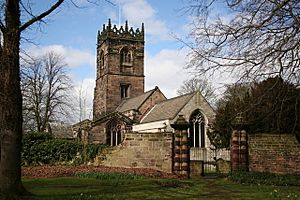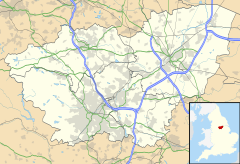Aston, South Yorkshire facts for kids
Quick facts for kids Aston |
|
|---|---|
 All Saints' church |
|
| OS grid reference | SK460848 |
| Civil parish |
|
| Metropolitan borough |
|
| Metropolitan county | |
| Region | |
| Country | England |
| Sovereign state | United Kingdom |
| Post town | SHEFFIELD |
| Postcode district | S26 |
| Dialling code | 0114 |
| Police | South Yorkshire |
| Fire | South Yorkshire |
| Ambulance | Yorkshire |
| EU Parliament | Yorkshire and the Humber |
| UK Parliament |
|
Aston is a friendly village located in South Yorkshire, England. It's part of the Metropolitan Borough of Rotherham. This village is about 3 kilometers (2 miles) away from the fun Rother Valley Country Park.
Contents
Discovering Aston's Past
Aston used to be a quiet farming village. You can still see some old farm buildings along the main road today. In the early 1900s, more people moved here. This was because new coal mines opened nearby, creating jobs.
Aston joined with two other local villages, Aughton and Swallownest. Together, they formed the Aston cum Aughton civil parish.
What Does "Aston" Mean?
The name "Aston" is quite old. It comes from Old English words. It doesn't mean "eastern farm" like some other places called Aston. Instead, it comes from tun, which means "farm" or "village."
The first part of the name is a bit of a mystery. In 1039, it was written as Essetone. This might mean it came from ǣsc, which means "ash tree." So, it could mean "ash tree village," but we can't be totally sure!
Important Places in Aston
Aston has some really interesting old buildings and landmarks. They tell us a lot about the village's history.
Aston Hall: A Grand Old House
At the eastern end of Aston, you'll find Aston Hall. This is a very old and important building. It's listed as a Grade II* building, which means it's historically important. It started as a large country house.
Over the years, it was even a hospital for a while. Now, it's a hotel and restaurant. Aston Hall Cricket Club plays its home games close to the Hall. There's a street nearby called "The Chase." This name suggests that the houses there now stand on land that used to be hunting grounds for the Hall.
Church of All Saints: Aston's Oldest Building
Right next to Aston Hall is the Church of All Saints. This is the oldest building still standing in the village. It's a Grade I listed building, meaning it's extremely important historically. The church was built where an even older church once stood. That first church was mentioned in the Domesday Book way back in 1086.
Parts of the current church date back to the 1100s, 1300s, and 1400s. It has been repaired and updated over the years. For example, the chancel (the part near the altar) was rebuilt in the 1800s. Inside the church, you can find special plaques. They remember William Mason, who was a rector (a type of priest) there a long time ago.
The old rectory building, called High Trees, is also very old. It was worked on by a famous architect named John Carr. High Trees and several other buildings along Worksop Road are also listed as Grade II. These buildings date from the 1700s and early 1800s. Further north, on Aughton Lane, is the William Layne Reading Room. This building used to be Aston Old School, which started in 1738. Next to it, you'll see a war memorial that was put up in 2011.
Education in Aston
Aston has great schools for young people.
Aston Academy is the local high school. It's known for its strong programs in math and computing. Most students come from the Aston-cum-Aughton area. Others travel from nearby villages like Beighton, Woodhouse, and Treeton.
There are also several primary schools in the area:
- Aston C of E (Church of England)
- Aston Hall Primary
- Aston Lodge Primary
- Aston Springwood Junior & Infant School
- Swallownest Primary
- Aughton Primary
- Aston Fence Junior & Infant


